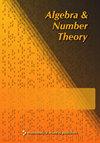同一阶型的可解和不可解有限群
IF 1
1区 数学
Q2 MATHEMATICS
引用次数: 0
摘要
我们构造了两个大小为2365⋅3105⋅7104的群:一个可解群G和一个不可解群H,使得对于每一个整数n,这两个群有相同数量的n阶元素。这回答了John G. Thompson在1987年提出的一个问题。本文章由计算机程序翻译,如有差异,请以英文原文为准。
Solvable and nonsolvable finite groups of the same order type
We construct two groups of size : a solvable group and a nonsolvable group such that for every integer the groups have the same number of elements of order . This answers a question posed in 1987 by John G. Thompson.
求助全文
通过发布文献求助,成功后即可免费获取论文全文。
去求助
来源期刊

Algebra & Number Theory
MATHEMATICS-
CiteScore
1.80
自引率
7.70%
发文量
52
审稿时长
6-12 weeks
期刊介绍:
ANT’s inclusive definition of algebra and number theory allows it to print research covering a wide range of subtopics, including algebraic and arithmetic geometry. ANT publishes high-quality articles of interest to a broad readership, at a level surpassing all but the top four or five mathematics journals. It exists in both print and electronic forms.
The policies of ANT are set by the editorial board — a group of working mathematicians — rather than by a profit-oriented company, so they will remain friendly to mathematicians'' interests. In particular, they will promote broad dissemination, easy electronic access, and permissive use of content to the greatest extent compatible with survival of the journal. All electronic content becomes free and open access 5 years after publication.
 求助内容:
求助内容: 应助结果提醒方式:
应助结果提醒方式:


